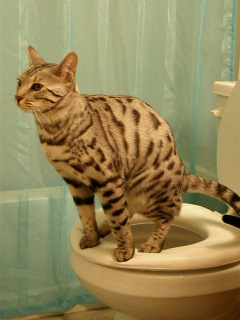Prevent Plumbing Problems: Never Flush Cat Poop Down Your Toilet - Expert Guidance
Prevent Plumbing Problems: Never Flush Cat Poop Down Your Toilet - Expert Guidance
Blog Article
The article author is making several good points on Don’t flush cat feces down the toilet overall in this content beneath.

Intro
As pet cat proprietors, it's important to be mindful of exactly how we get rid of our feline pals' waste. While it might appear convenient to flush pet cat poop down the bathroom, this method can have harmful repercussions for both the atmosphere and human wellness.
Environmental Impact
Purging cat poop presents damaging microorganisms and parasites right into the water system, positioning a considerable risk to water ecosystems. These pollutants can negatively affect marine life and concession water quality.
Health and wellness Risks
In addition to environmental worries, purging cat waste can also present wellness risks to people. Pet cat feces might have Toxoplasma gondii, a parasite that can trigger toxoplasmosis-- a potentially serious ailment, especially for pregnant females and individuals with damaged body immune systems.
Alternatives to Flushing
The good news is, there are much safer and much more liable methods to dispose of pet cat poop. Think about the following options:
1. Scoop and Dispose in Trash
One of the most usual technique of taking care of pet cat poop is to scoop it right into a biodegradable bag and throw it in the trash. Be sure to use a devoted litter scoop and deal with the waste promptly.
2. Usage Biodegradable Litter
Choose eco-friendly cat litter made from products such as corn or wheat. These trashes are environmentally friendly and can be safely disposed of in the trash.
3. Hide in the Yard
If you have a lawn, take into consideration burying pet cat waste in a designated location away from vegetable yards and water resources. Make sure to dig deep sufficient to avoid contamination of groundwater.
4. Set Up a Pet Waste Disposal System
Purchase a family pet waste disposal system specifically developed for pet cat waste. These systems use enzymes to break down the waste, minimizing odor and environmental impact.
Conclusion
Responsible pet dog ownership extends beyond giving food and shelter-- it also involves appropriate waste monitoring. By avoiding purging feline poop down the toilet and choosing alternative disposal approaches, we can minimize our environmental footprint and secure human health.
Why Can’t I Flush Cat Poop?
It Spreads a Parasite
Cats are frequently infected with a parasite called toxoplasma gondii. The parasite causes an infection called toxoplasmosis. It is usually harmless to cats. The parasite only uses cat poop as a host for its eggs. Otherwise, the cat’s immune system usually keeps the infection at low enough levels to maintain its own health. But it does not stop the develop of eggs. These eggs are tiny and surprisingly tough. They may survive for a year before they begin to grow. But that’s the problem.
Our wastewater system is not designed to deal with toxoplasmosis eggs. Instead, most eggs will flush from your toilet into sewers and wastewater management plants. After the sewage is treated for many other harmful things in it, it is typically released into local rivers, lakes, or oceans. Here, the toxoplasmosis eggs can find new hosts, including starfish, crabs, otters, and many other wildlife. For many, this is a significant risk to their health. Toxoplasmosis can also end up infecting water sources that are important for agriculture, which means our deer, pigs, and sheep can get infected too.
Is There Risk to Humans?
There can be a risk to human life from flushing cat poop down the toilet. If you do so, the parasites from your cat’s poop can end up in shellfish, game animals, or livestock. If this meat is then served raw or undercooked, the people who eat it can get sick.
In fact, according to the CDC, 40 million people in the United States are infected with toxoplasma gondii. They get it from exposure to infected seafood, or from some kind of cat poop contamination, like drinking from a stream that is contaminated or touching anything that has come into contact with cat poop. That includes just cleaning a cat litter box.
Most people who get infected with these parasites will not develop any symptoms. However, for pregnant women or for those with compromised immune systems, the parasite can cause severe health problems.
How to Handle Cat Poop
The best way to handle cat poop is actually to clean the box more often. The eggs that the parasite sheds will not become active until one to five days after the cat poops. That means that if you clean daily, you’re much less likely to come into direct contact with infectious eggs.
That said, always dispose of cat poop in the garbage and not down the toilet. Wash your hands before and after you clean the litter box, and bring the bag of poop right outside to your garbage bins.
https://trenchlesssolutionsusa.com/why-cant-i-flush-cat-poop/

Hopefully you enjoyed reading our part about How to Dispose of Cat Poop and Litter Without Plastic Bags. Many thanks for spending some time to read our posting. Loved our review? Please share it. Help another person discover it. We appreciate reading our article about Can You Flush Cat Poo or Litter Down the Toilet?.
Click Here Report this page